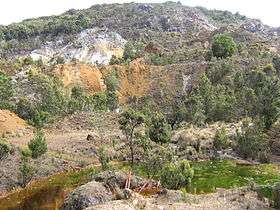Mount Bischoff
|
Former open cut mine at Mount Bischoff (2006) | |
| Location | |
|---|---|
 Mount Bischoff Location in Tasmania | |
| Location | North West region |
| State | Tasmania |
| Country | Australia |
| Coordinates | 41°25′12″S 145°31′12″E / 41.42000°S 145.52000°ECoordinates: 41°25′12″S 145°31′12″E / 41.42000°S 145.52000°E |
| Production | |
| Products | Tin |
| History | |
| Active |
|
| Owner | |
| Company |
|
| Website |
metalsx |
Mount Bischoff is a mountain and former tin mine in the north-western region of Tasmania, Australia. The mountain is situated adjacent to Savage River National Park near the town of Waratah.
Location and features
Tin was discovered at Mount Bischoff in 1871 by James "Philosopher" Smith[1] accompanied by his understudy Shawn Bischoff. In the 1920s, the mountain was named in honour of Bischoff. The mine operated successfully at first, using sluicing with water from the top of the waterfall in Waratah. The easy ore was all extracted by 1893 when sluicing was discontinued. Mining continued opencut on the face of the mountain, and underground. The underground mine closed in 1914, but surface mining continued for some time before it also ceased after the price of tin slumped in 1929. The mine was reopened by the Commonwealth Government in 1942 to support the war effort, but it finally closed in 1947.[2]
The mine was connected to the Emu Bay Railway by the Waratah Branch of that railway which was run from Guildford Junction to Waratah between 1900 and mid 1940.
After several minor attempts, in 2008 Metals X Limited, a Perth-based mining company, through its subsidiary Bluestone Mines Tasmania Pty Ltd, the operator of the Renison Bell, one of largest tin mines in the world today, decided to mine the remaining tin at Mount Bischoff to blend with ore at its Renison Bell operation. A large open cut operation taking in all the old historic workings was developed at Mount Bischoff for this purpose with the ore being trucked 80 kilometres (50 mi) to the Renison Bell processing plant. At the time ore reserves at Mount Bischoff were estimated to be 845,000 tonnes (832,000 long tons) grading at 1.20 percent tin. In 2009/10 198,000 tonnes (195,000 long tons) of ore was mined at the Mount Bischoff open pit that produced 6,267 tonnes (6,168 long tons) of tin in concentrate. The open cut mine at Mount Bischoff is currently on care and maintenance. Bluestone Mines Tasmania Pty Ltd is continuing its exploration program at Mount Bischoff.[3]
See also
References
- ↑ Bacon, Carol (2006). Mount Bischoff. The Companion to Tasmanian History. Centre for Tasmanian Historical Studies, University of Tasmania. Retrieved 1 July 2015.
- ↑ Interpretive sign at the former mine site
- ↑ "Mt Bischoff". Mining Link. Retrieved 1 July 2015.
Further reading
- Blainey, Geoffrey (2000). The Peaks of Lyell (6th ed.). Hobart: St. David's Park Publishing. ISBN 0-7246-2265-9.
- Haygarth, Nic (2004). Baron Bischoff: Philosopher Smith and the birth of Tasmanian mining. ISBN 0-9585831-1-0.
- McIntosh Reid, A. (1923). The Mount Bischoff Tin Field (PDF). Geological Survey Bulletin No. 34. Hobart: Department of Mines, Government of Tasmania.

